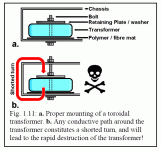So I was getting ready to pursue my build(s), and contemplated how/where to place the toroid.
But then, if you look up the topic, you'll find plenty dreadful warnings a la "don't put a screw through the middle of the toroid or the thing will blow up" etc. which of course frightened me.
Here's what I found:
You have to make sure the bolt/screw doesn't touch both sides (or top/bottom) of the chassis, and you're fine.
Or you go creative and use something non-metallic.
But then, if you look up the topic, you'll find plenty dreadful warnings a la "don't put a screw through the middle of the toroid or the thing will blow up" etc. which of course frightened me.
Here's what I found:
You have to make sure the bolt/screw doesn't touch both sides (or top/bottom) of the chassis, and you're fine.
Or you go creative and use something non-metallic.
Attachments
Yes, "b" is very bad.
If you are designing something very sensitive, then you should take care of next level things - use non-feromagnetic screw, because usual steel one - will increase toroid magnetic fields (a little).
If you are designing something very sensitive, then you should take care of next level things - use non-feromagnetic screw, because usual steel one - will increase toroid magnetic fields (a little).
Yes, "b" is very bad.
If you are designing something very sensitive, then you should take care of next level things - use non-feromagnetic screw, because usual steel one - will increase toroid magnetic fields (a little).
Thanks for the advice, Vovk z
I was thinking of using a wooden centerpiece (oak) and Aluminium or stainless steel screws. And of course having the whole not clamped between any chassis-parts.
A set of cable-ties is often used for smaller toroids, typically 4 of them, but that requires more holes drilled, and they eventually become brittle.
…cable-ties…
To mount the toroid, or to control the wires?
(To control the wires, I was thinking of using the old-school aviation technique, as behind this link, chapter 8 (file is attached below) just for the elegance and to have an excuse not to finish a project too fast 🙂 ...
Attachments
The problem is because they are conductive, not because they are magnetic.and Aluminium or stainless steel screws.
The problem is because they are conductive, not because they are magnetic.
Yup, but I‘d split them and use a non-conductive piece inbetween (like, oak) – seems a bit awkward, but should work.
I guess it also would work if I make sure the bolt can‘t touch the case (rubber on it or so) ... ?
(a) in your original image, is easy to do. I even have a toroid (300VA) mounted vertically against a case side panel using this method. I simply used 2 rubber pads, one between the toroid and the case, and one between the toroid and the mounting washer. Then I used a high tensile bolt with the right washers to distribute the load, and prevent loosening of the nut. I included a locknut, just to be safe.
Aluminium or stainless steel is ok to screw a toroid, no problem (I talk about "a" mounting type, because "b" type is inappropriate).The problem is because they are conductive, not because they are magnetic.
A use of "b" type with non-conductive materials is ok, but it isn't convenient usually.
Aluminium or stainless steel is ok to screw a toroid, no problem (I talk about "a" mounting type, because "b" type is inappropriate).
A use of "b" type with non-conductive materials is ok, but it isn't convenient usually.
Thank you, Vovk Z
No matter what Material I‘ll end up using, I will not go the b-way.
It is probable that I‘ll shield the torpid (mu-metal seems hard to find though), but the torpid will stay clear of the upper side ��!
Last edited:
It also isn't an issue of the toroid being touched or not, it's an issue of a short winding around it. Make sure that you won't fasten the Mumetal shield with the same central bolt you're fastening the toroid with. Alternatively, you need to insulate the bolt either from the chassis or the Mumetal.
Best regards!
Best regards!
- Home
- Design & Build
- Construction Tips
- Proper toroid mounting techniques
